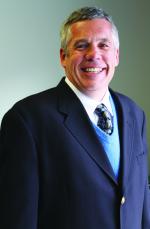CHICAGO — Thinking of making a sizable outlay at your drycleaning operation?
“The best advice I can give is: do your research and know what you’re buying,” says Mike Scuola, owner of family-operated Saratoga Cleaners, located in Saratoga Springs, N.Y.
“Today’s markets are tough and when business is slow, it’s hard to think about taking money out of your pocket to reinvest in equipment,” he says. “There may be some good upsides.”
His business is located in a scenic resort town of 26,000 in upstate New York, known for its hot springs, just a little past the halfway point if you’re driving from New York City up to Lake Placid.
Scuola and his family opened their drycleaning operation in 2011. His family built their own store from scratch. His dad John has been in the business for almost 40 years.
American Drycleaner caught up with Scuola recently to find out what he thinks it takes to make capital improvements and upgrades today.
“In a rapidly changing environment, from fashion to fabrics, a wetcleaning machine might be a good idea for dry cleaners who have not started to utilize that part of the market yet,” he says.
It appeals to the environmentally conscious consumer and can be a better tool to get some of those tough, water-based stains out that are hard to remove on the dry side, he explains.
“I did just start chasing down some wholesale accounts and will have a large influx in linens,” Scuola says. “Now that we will be getting much more than we are used to, I will be shopping for a new, larger wetcleaning machine and other equipment.”
Timing is key, of course. So when does a dry cleaner decide to reinvest and revitalize their business?
“Everyone has their own theory of when this should be done. In my opinion, get the work first, then reinvest in equipment to support growth, rather than spending money and hoping the work follows,” Scuola suggests.
As far as revitalizing in terms of equipment, think about when it becomes too costly to keep replacing parts, or it’s consuming too much of your time working on it.
“When it comes to your call office and storefront, I believe that should be kept up on,” he notes. “When people are bringing their clothes, they want to walk into a clean, updated establishment. Make it look more like a bank rather than a cleaners.”
Many decisions come into play when a drycleaning owner/operator gets ready to plunk down for new stuff. Some of the factors, besides purely a need to replace, include: upgrading the look of the store; how much more efficient the store will be; keeping the cash flowing; and return on investment.
RECOUP
You say you’re gonna revitalize! You say today’s the day! You’re psyched and ready! You’re experiencing “buyer’s high!”
You’ve got one foot on the proverbial ladder and want to begin the climb. But there is work to do.
Think first of not only researching your needs and wants, but also give heed to the financial ledger and your expectations of costs you will get back.
“For us, we really look at a return on investment (ROI) of five years or less. And the capital expense has to be directly linked to reducing another expense or substantially improving quality of our client experience,” says Dave Coyle, owner of In The Bag Cleaners in Wichita, Kan.
The 43-year-old Coyle and wife Aram have three kids, with another on the way. They started the operation in December 2000 and currently have 16 locations, 72 team members, and over 22,000 regular clients.
“Last April, we added our largest capital expense in a long time,” Coyle says. “We installed a Metalprogetti assembly conveyor with three load stations and seven extract arms; an integrated bagging machine; and a batching conveyor to deliver the clothing to the correct drivers’ rail.
“This cost us over $250,000 but has saved us about 300 hours of labor per week," he says, adding, “which gives us an ROI right at four years.”
It used to be that Coyle’s business would invest in equipment only when something was broken and no longer operable, he explains. “Now we are trying to stay ahead of the curve and treat capital expenses as investments in our future.”
Tom Markuszewski, a franchise owner of CD One Price Cleaners in the Chicagoland area, seems to agree on strategizing, noting he recently made a capital improvement on an automated sorting and bagging system.
“The decision was made to improve the productivity of our production process by 25%,” says Markuszewski. “This was a significant decision that dramatically changed our production process. The investment was a success, and we achieved our objective.”
Over time, your facility ages and possibly grows, therefore the need to replace and add capital increases, he points out. “These decisions are driven by the goal to improve the business, such as quality and productivity.”
He relates that a drycleaning business must have an ongoing list that prioritizes its capital needs.
Business owners should constantly be searching for ways to improve their business, he says. “Capital planning is a critical part.”
Check back Thursday for the conclusion.
Have a question or comment? E-mail our editor Dave Davis at [email protected].


